2 - Components
Voidream is a two player competitive deckbuilding game. In the constructed play format, each player must bring their own deck, consisting of the following cards:
- 39 Dream cards, with numbered backs.
- 1 double sided bastion.
- 8 arcana.
- 1 double sided mind card.
Some bastions may allow the player to tweak the proportions above (see the deckbuilding section for details), but the vast majority of Voidream decks use the numbers above.
Voidream is played exclusively with cards. No tokens, dice, coins or dials are necessary. This section introduces Voidream's different card types, so you can familiarize yourself with their looks and roles before covering the rules of play.
Arcana
Arcana are the most important card in Voidream. Arcana represent lucid, conscious actions taken in the dream world. Whether it's talking to an entity, taking a leap of faith, or simply pushing back an intrusive thought, you'll need to use an arcanum.
Your hand is composed of eight different arcana, which are available to you from the start of the game. The most basic action in Voidream is to play an arcanum.
Arcana consist of:
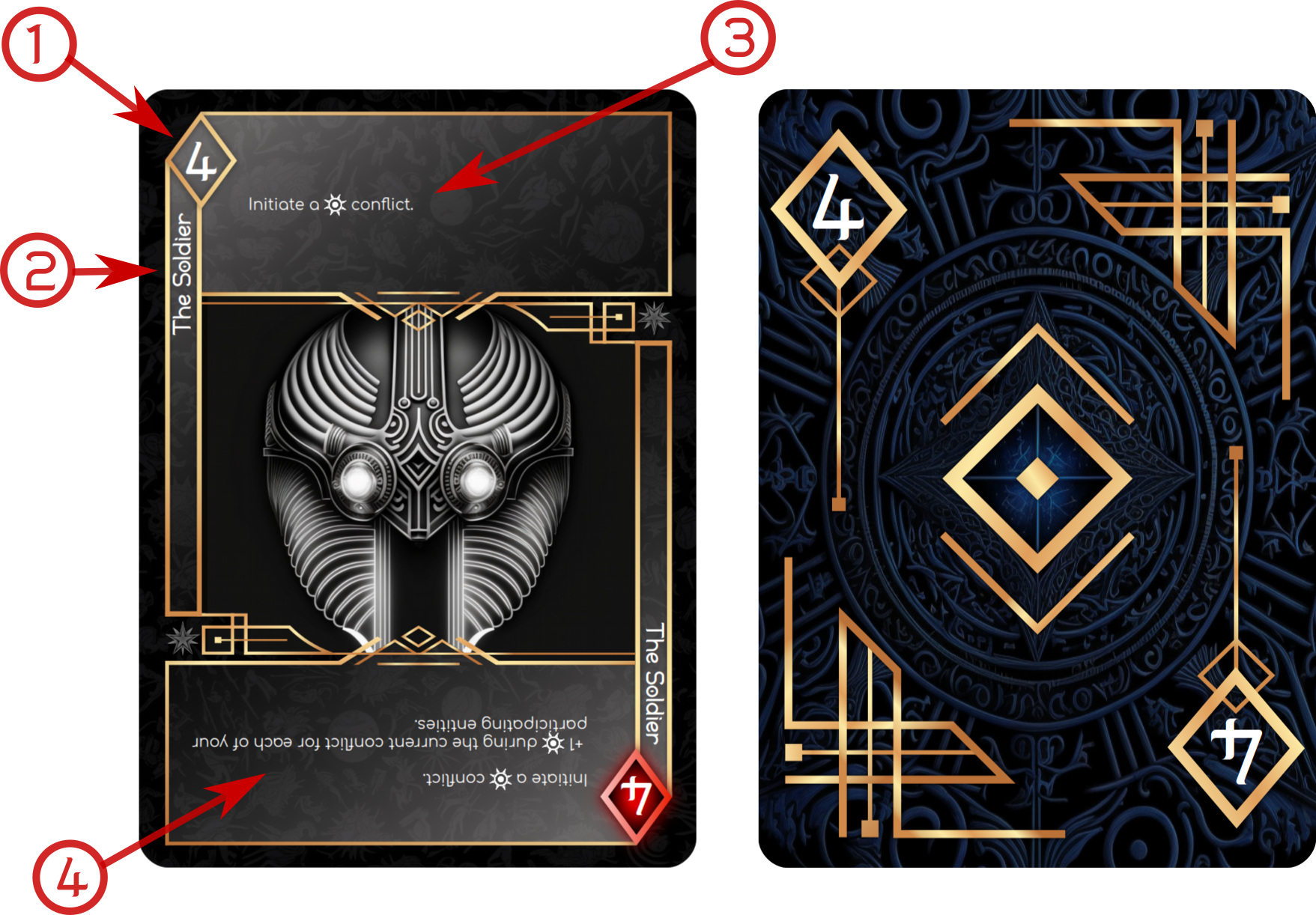
- (1) A numeric value, (top left), from 1 to 4. Higher values represent arcana closer to the waking, conscious mind. These are flexible and can be used frequently. Lower values represent arcana deeply rooted in the subconscious, with more powerful but more restricted effects. The value is also printed on the back of the card; this gives you a hint as to what tools your opponent has available at any time. Use this information carefully!
- (2) The card's title. Each of your eight arcana must have a different one.
- (3) The rules text (top). This shows what happens when the arcanum is played. Arcana resolve their effects immediately, and are sent to the arcana discard pile face up.
- (4) The inverted rules text (bottom). Dreamers may exert their energy to play a more powerful version of the arcanum, called an inverted arcanum. Not only the effect is more impactful; it also will return all discarded arcana to your hand! However, it comes at a cost: an arcanum that is played inverted is sent to the Void pile and lost forever.
If the rules text on an arcanum describes an ongoing effect (for example: "Your entities cannot be destroyed"), the effect applies until the end of the current phase, unless specified otherwise.
Strategy: As the game progresses, you will need to weave arcana and inverted arcana smartly to always have weapons at your disposal. You must however spend them judiciously: if you run out of cards too quickly, you will be at the mercy of Nightmare.
Dream Cards
While arcana are flexible, they're not too powerful. They're subtle tools which influence the Dream, wielded by the waking mind. The real force behind the dreamer's arsenal is found in the Dream deck, consisting of 39 dream cards and a double-sided bastion card.
Unlike other card games, there's no concept of drawing in Voidream. Instead, some actions allow you to evoke. In order to evoke, you must secretly look at the top card of the deck, then decide whether to play it or return it to the top.
Through evocation and other actions that affect the top of the deck, skilled players manipulate the Dream to their advantage. However, they're not doing this blindly: Dream cards have a value from 1 to 4, once again representing how close they are to the conscious mind, and this value is printed on the back of the cards. So, while it's not easy to know exactly what's coming, the number on the top of the deck (called the dream's depth) hints at what lurks on the surface of your mind.
Dream cards come in five different flavours: thoughts, memories, entities, constructs, and the all-important bastion.
Thoughts
Thoughts are the simplest form of Dream card. They are manifestations of the Dreamer's imagination, causing an immediate change on the world around them. Much like arcana, they perform their effect immediately, and are sent to the Dream discard pile face up.
Thought cards consist of:
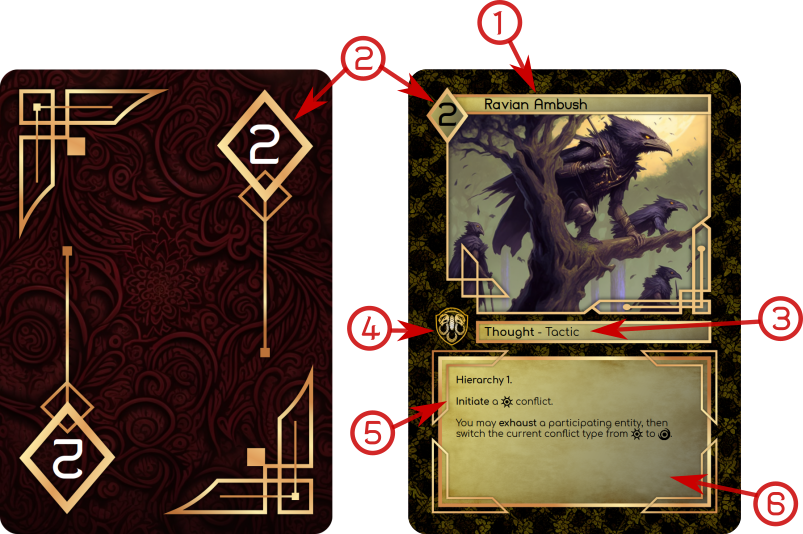
- (1) Their title at the top.
- (2) Their value (top left). As with all other kinds of Dream card, this matches the value printed on the back of the card.
- (3) The text "Thought" (center), identifying them as one, as well as an optional type that other cards may refer to.
- (4) The faction symbol (center left), identifying which of the Dream's factions it belongs to.
- (5) The rules text (bottom), showing what effects must be resolved when the card is played. They are read from top to bottom. Each separate effect line must be resolved fully or, in case its conditions can't be met, skipped.
- (6) Optional flavour text, expanding the narrative world of Voidream.
Just like arcana, if the rules text on a thought card describe an ongoing effect, it applies until the end of the current phase, unless specified otherwise.
Memories
Memories represent lingering fragments of the Dreamer's mind, imposing a lasting effect on the dream world.
Memories look very similar to thoughts, and have the same card elements. The difference is that memory card effects stay active indefinitely, or until the memory is destroyed by another card effect. Once played, a memory stays on the player's play area, where any text printed on it is permanently active.
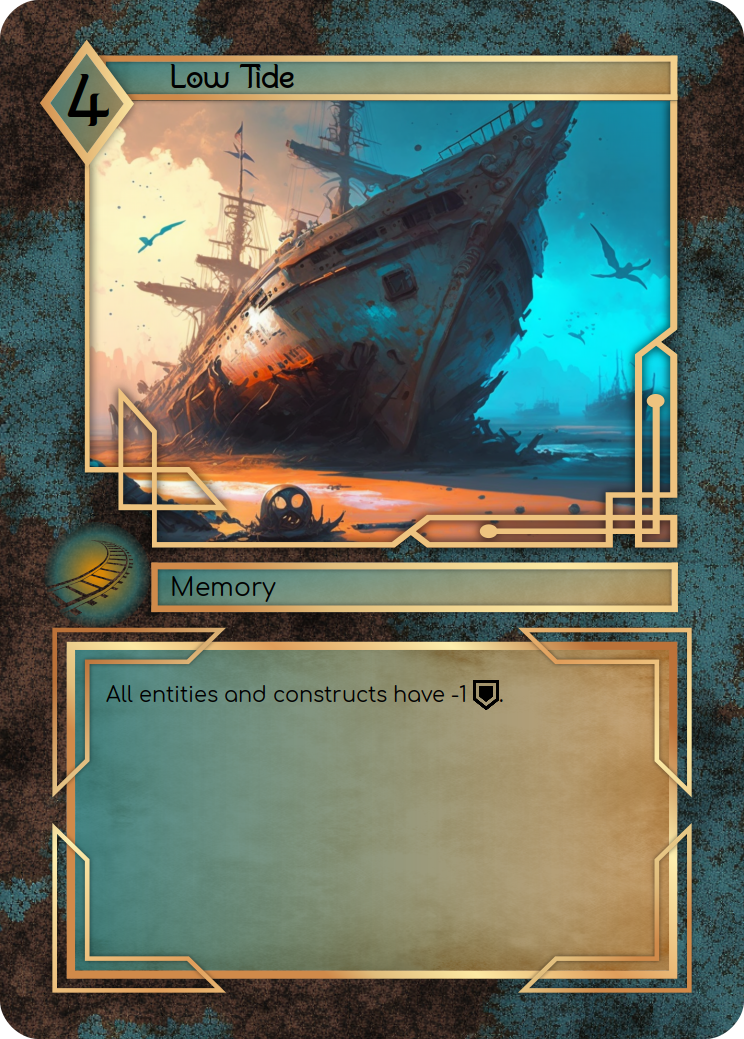
Memories, as well as other persistent Dream cards such as entities, can sometimes be exhausted (turned sideways) as an action, in order to cause an effect. In that case, they will ready at the start of the next round.
Some memories can be attached to other entities or memories. Attached memories move with the card they're attached to, and are discarded if their host card leaves play. A card that is attached cannot itself have attachments.
Entities
Entities are the denizens of the Dream, called to lend the player their aid. Whether they're other Dreamers, synthetics (imagined by the Dreamer themselves), or natives to the realm, entities possess their own intelligence and will.
Aside from the elements in common with thoughts and memories, entities have additional elements at the bottom of the card:

- (1) Their dawn value, representing their prowess in dawn conflicts. Generally, a higher number is better. Depending on the entity, this value may symbolize their physical might, glamour, their persuasion skills, and countless other abilities involving force and domination.
- (2) Their stability value, representing their ability to endure hardship and remain at the Dreamer's side. Generally, higher is better. Stability may symbolize the entity's resistance to harm, mental endurance, loyalty, structural integrity, and many others.
- (3) Their dusk value, showing their impact in dusk conflicts. Generally, a lower number is better. Dusk conflicts are encounters of cunning, subterfuge and betrayal where blades turn against the Dreamer. This value may represent the entity's treachery, selfishness, ability to lie, their tendency to adopt the twisted shape of Nightmare, as well as many other dark traits.
Like memories, entities remain on the play area once played, until they're sacrificed or destroyed, either by another card effect or by participating in a conflict.
Constructs
Constructs are large material structures conjured or recruited by the Dreamer. They significantly alter the tapestry of the dream world, offering the Dreamer protection and refuge. They take a tremendous amount of energy to maintain, so each Dreamer may only have a single construct active at any given time.
When you play a construct, it's immediately placed on top of your deck face up. This effectively blocks your ability to evoke, in exchange for sizeable defensive (and sometimes offensive) benefits. If an active construct moves deeper into the deck, it remains face up and may be uncovered later.
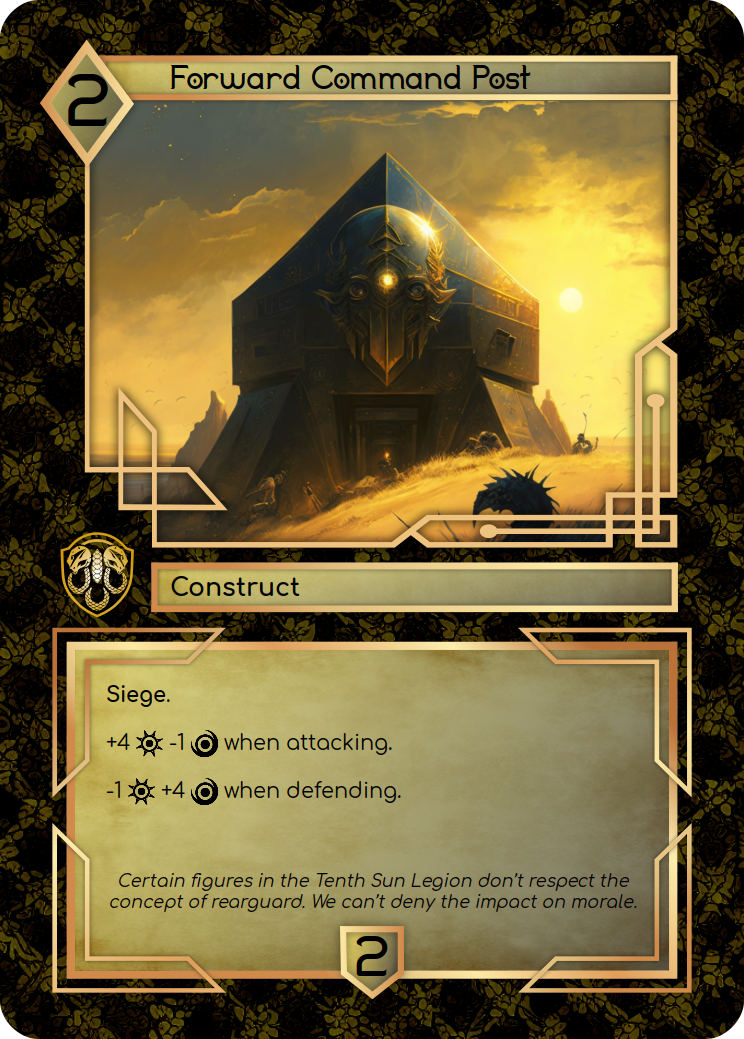
Like entities, constructs have a stability value, representing the difficulty of taking them down. Unlike entities, constructs cannot directly participate in conflicts, so they possess no dawn or dusk values.
The Bastion
The bastion is the Dreamer's ultimate fortress. It's a material location that serves as your source of power and maintains your lucid connection to the dream world. Whether it's an imposing building, a vehicle, or a drifting patch of land, if your bastion is destroyed you shall be exiled to the blurry, mindless sleep of the past, forced to roam the realm as bastionless.

The bastion card is a special kind of construct. In fact, it behaves as a construct for all purposes, with a few additions:
- After the deck is shuffled at the start of the game, the bastion card is placed at the bottom of the deck, face up. It is always active, and can never be flipped face down.
- At any point, if your Dream deck doesn't contain a bastion, your connection to the Dream is severed and you immediately lose the game.
- The bastion can only leave the deck if destroyed by damage. Any effects that would cause a bastion to be directly destroyed without dealing damage, flipped face down, or moved to a different game area will automatically fail.
- The back of the bastion card contains that bastion's deckbuilding rules (1), which details the limits and restrictions for building your deck. Some bastions have special effects that trigger at the beginning of the game, which are also detailed here. In the example above, this bastion requires a 40 card Dream deck (of which 8 cards may belong to a guest faction), and a hand consisting of The Dreamliner and another 7 arcana (of which 2 may belong to a guest faction). Read the section on deckbuilding for more details.
Stategy: To prevail against your opponent you must tear through the layers of their Dream until their bastion is exposed, then take it down with a decisive attack. Your own Dream cards are the main tool to achieve this, but beware: every card you remove from the deck means one fewer layer of protection on top of your own bastion.
The Mind Card
The last, and most complex card in Voidream is the single mind card, which begins the game in play. The mind card represents the Dreamer themselves, the driving emotion or trait that compels them to pursue their goals. It acts as a counter, keeping track of the amount of arcana you are able to play.
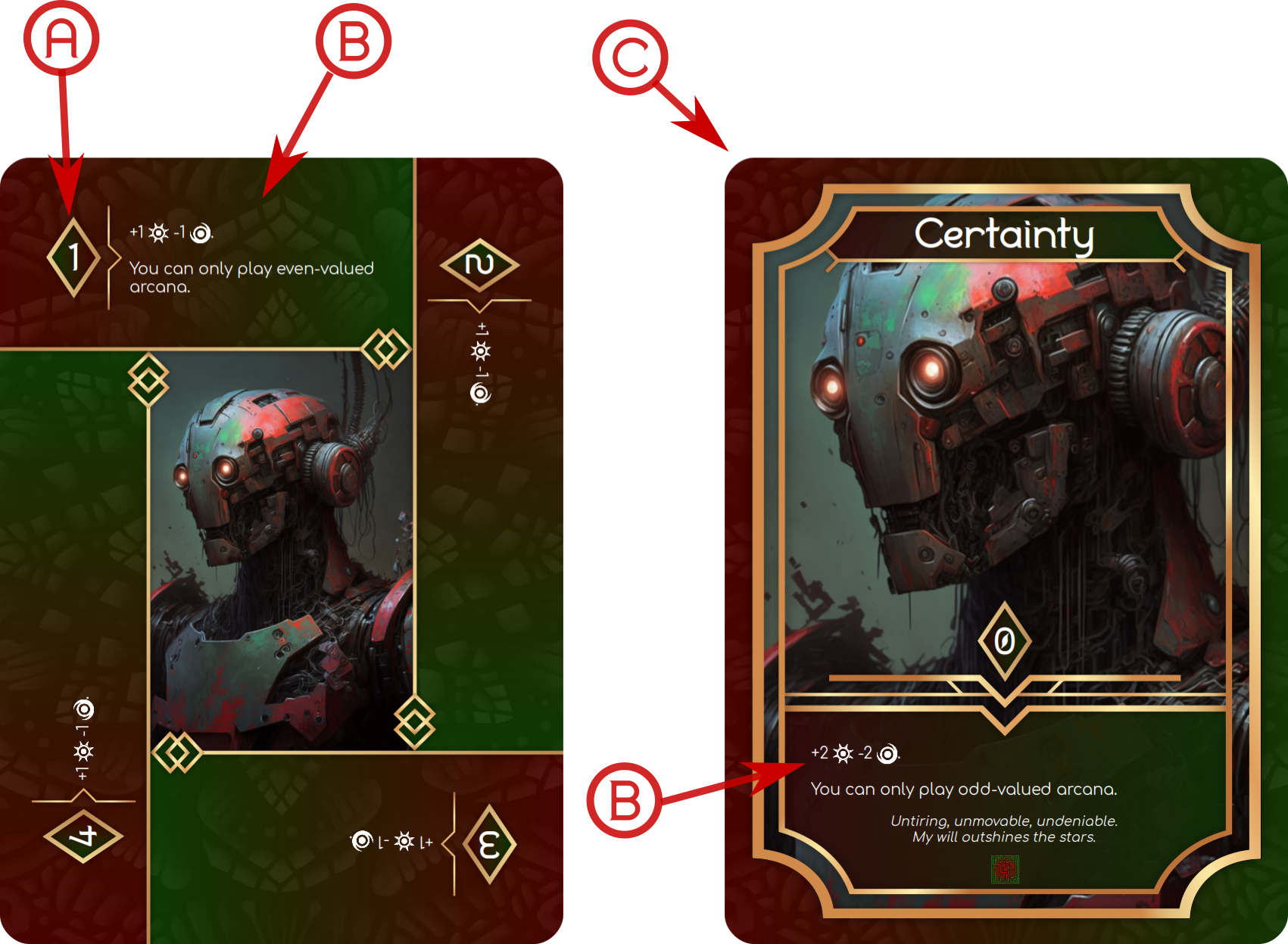
At the start of every round, you must rotate your mind card until the upright number (A) matches the depth of your Dream (the value on top of your deck). Then, as a cost to play arcana though the round, you must first turn your mind card, reducing the count by one. When you reach zero, flip the card to the spent side (C).
Mind cards aren't simple convenience reminders, though. As Dreamers navigate the hardship of conflict, their spirits rise and fall, their moods brighten and worsen. Any text in your mind card that is currently upright (B) is always active, so be sure to sequence your arcana correctly so you can ride the peaks and cross the valleys of emotion.

Example: The image above shows the progress of a typical round, where the Chimeric Court player begun with a card of value 2 on top of their deck. Since their depth is 2, they set the starting position of their mind card to 2, which already grants them a +1 dawn -2 dusk modifier. (Dawn and dusk will be explained in the conflict section).
As a cost to play the first arcanum of the round, they turn the card clockwise first. Since the text is immediately active, any arcanum they play right now would not be capable of initiating a conflict.
Later, they flip the card to the spent side to play the last arcanum of the round. Thanks to navigating the difficult requirements of the Cunning card, they're left with a powerful +2 dawn -2 dusk modifier for their final attack!
The Depth Rule
Now that you know about all card types in Voidream, we reach the most important rule about playing arcana; one that binds the arcana and Dream deck together:
The Depth Rule: In order to play an arcanum, that arcanum's value must be equal or higher than your current depth.
For example, if the top of the deck shows a 3, only arcana of value 3 and 4 can be played. Dreamers must be in the right mindset to tap deep into their well of creativity!
Strategy: High values in your Dream deck mean you will have access to more actions, as your mind card will copy the value on top of your deck at the start of each round. However, always having a high value on top of your deck severely limits the power and variety of arcana you have access to.
A skilled Dreamer rises and falls through the layers of the Dream to enjoy the best of both worlds, starting the round at a high depth to focus their conscious mind, then descending to the subconscious to unleash their true potential.